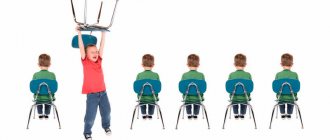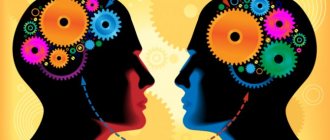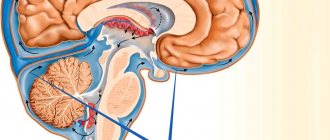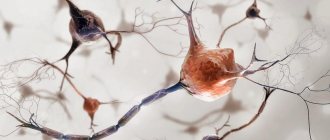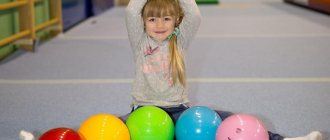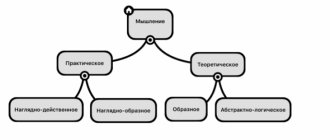Chapter 11 VIOLATIONS OF WILL AND ATTENTION
WILL is a person’s ability to act consciously and purposefully, suppressing immediate desires and aspirations. In a volitional act there are distinguished:
1) the emergence of motivation, awareness of the goal of action and the desire to achieve it;
2) awareness of a number of possibilities for achieving the goal, hesitation between agreement with the goal and objections to it;
3) the struggle of motives and the choice of the most appropriate method of action;
4) making one of the possible decisions;
5) implementation of the decision made, motivation to begin an action and bring it to completion.
Neurophysiological mechanism
is based on the freedom reflex, called by ethologists “motivation of resistance to coercion”, on overcoming a competing need that stands in the way of satisfying some other need that primarily initiated behavior, on the emergence of activity in relation to which the subdominant motive is an obstacle, “internal hindrance” "
Age characteristics.
Mastery of basic movements before the age of 3 is a prerequisite for the formation of volitional processes. At the initial stages, the child’s will is just a collection of desires. An action becomes volitional only then (between 2 and 5 years) when it is dictated by necessity, but is not of interest in itself. The demands and instructions of adults, participation in household work, children playing together, and educational activities develop volitional actions. Will is cultivated through overcoming difficulties, the example of elders, and the influence of peers. Thus, there are three degrees of spontaneity:
1) early preschool age - unawareness of actually existing external regulation and lack of internal regulation of behavior;
2) school age - awareness of the need to subordinate one’s behavior to rules in the absence of true spontaneity;
3) adolescence - genuine spontaneity. The motives of volitional actions are desires, motivations, aspirations. The motivational sphere includes both conscious (volitional) and non-
160
fairly conscious actions based on various motives (drives, attitudes, etc.).
VIOLATIONS OF VOLITIONAL ACTIVITY. Disorders of the will may be associated with changes in the level of motivation for activity, the degree of awareness of the goal, i.e. with the formation of a motive, decision-making and implementation of action.
Weakening (decrease) of volitional activity.
Hypobulia is
a decrease in volitional activity. Associated with a weakening of drives, in connection with this, appetite decreases, sexual and defensive drives are suppressed, and activity decreases. It is observed to one degree or another in mental retardation, organic lesions of the central nervous system, and schizophrenic defects.
Abulia
- an extreme option for reducing volitional activity until all activity completely disappears. Most often found in deep schizophrenic defects.
Stupor -
motor numbness, manifested in absolute or almost complete immobility, with increased muscle tone. The patient lies in bed without moving, maintaining the same position. Most often, this is the position of the embryo (with the chin brought to the chest, arms bent at the elbows, knees bent and legs pressed to the stomach), sometimes another, even very uncomfortable position, but never changed independently. There are no reactions to what is happening around. The patient does not take care of himself; he performs natural needs in bed or withholds bowel movements and urination. The staff have to feed. Speech communication is impossible (mutism).
Substuporous state
- inhibited state without complete immobility. In this case, it is possible to freeze in certain positions for a short time (standing by the bed, with a raised arm or leg). Sometimes the patient can be brought out of this state for a short time. The patient partially takes care of himself, uses the toilet, and eats food. Either very quiet, monosyllabic speech or its absence is noted.
Children rarely experience stupor with complete immobility; its partial manifestations are more typical in the form of rudimentary signs of lethargy and occasional holding of one position (freezing with a spoon brought to the mouth, with a raised hand when dressing, etc.).
Both stupor and substuporous state are observed in catatonic schizophrenia, severe psychogenic depression or manic-depressive psychosis.
Strengthening (increasing) volitional activity.
Hyperbulia is
an increase in volitional activity associated with increased drives. May manifest itself in increased appetite, hypersexuality, aggression, active or even disinhibited behavior; Often these symptoms are combined.
6 Zak. 4344 \b\
Motor excitement
manifests itself either in the desire to move, or in more or less appropriate actions.
Catatonic excitement
- monotonously repeating (stereotypical), meaningless movements or impulsive motor acts. In younger children, it can manifest itself in the form of monotonous running in a circle, such stereotypical movements as jumping, shaking hands, etc. Older children shout, sing, swear, talk endlessly about something, shout out incoherent phrases.
Manic excitement
characterized by purposeful, but extremely active, agile and tireless behavior. The severity of arousal can vary from such that even a slight increase in productivity is possible, to complete chaotic behavior and actions. Speech activity also changes from increased talkativeness to speech incoherence. In children, manifestations of this condition can be in the form of excessive mobility with disobedience, foolishness and disinhibition of drives.
Epileptic agitation,
that occurs with dysphoria, as a rule, is provoked by the patient’s dissatisfaction with the attitude of others towards him. At the same time, aggression or destructive actions appear against the background of rage or anger. The latter are usually monotonous and last a long time. The patient shouts swear words for a long time, threats, having started a fight, cannot stop, performing the same blows or actions on the victim, destroying what comes to hand, without stopping, destroying everything around with the same movements.
Anxious excitement.
Depending on the degree of severity, this is the inability to sit still, throwing from side to side, wringing of hands, desire for self-harm and attempts to die, sobbing, wailing, lamentations, calls for help, curses against fate, calls to punish obvious and imaginary offenders .
Perversion of volitional activity (parabulia).
These include:
echopraxia
- copying the gestures and movements of others,
echolalia
- repetition of heard words and sentences,
non- gativism
resistance to external influences, mutism
refusal to speak, stereotypy
repetition of the same movements or actions, catalepsy
or waxy flexibility -
the patient maintains the position given to him,
pathological suggestibility -
unquestioning obedience to the instructions of others. All phenomena of parabulia relate to catatonia and occur either as individual symptoms or in one or another combination in schizophrenia.
162
DISORDERS OF WILL AND CORRECTIONAL PEDAGOGICAL PROCESS
A decrease in volitional activity to an unexpressed degree occurs with character anomalies and in these cases requires attention and support from educators. Pedagogical measures of influence on these children and adolescents should be aimed at stimulating activity in case of weak impulses, and in case of excessive activity, at developing the ability to manage their intensified drives. Individual symptoms, observed, for example, in mentally retarded or other children with developmental disabilities, cannot be an obstacle to their placement in special institutions, but require constant correction through educational measures. Severe manifestations of impairment of will, occurring in mental illness, require immediate consultation with a psychiatrist, and, if necessary, treatment.
ATTENTION - voluntary or involuntary selective orientation and concentration of mental activity on a specific object that is significant at the moment.
Neurophysiological mechanism.
Attention develops on the basis of an orienting reflex aimed at creating conditions in the body for perceiving changes in the external environment. It manifests itself in local activation (optimal activity) of certain brain structures that take part in a particular activity, and inhibition of other, “not working” functional systems of the brain.
Classification.
Attention can be involuntary, or passive, which is an automatic reflex reaction, and voluntary, or active, that is, conscious, purposeful concentration on a specific object while disconnecting from other events and phenomena. Selectivity, volume, stability, possibility of distribution and switchability of attention are distinguished. Attention can be directed both to external (toys, books, peers) and to internal objects (to your sensations, thoughts, feelings).
Age characteristics.
The rudiments of active attention appear already in the first year of life in the control of sensory organs and in games. A feature of children's attention is mobility, ease of transition from one object to another. Preschoolers are especially easily distracted. Voluntary attention is formed in preschool age due to the general increase in the role of speech in regulating the child’s behavior. A child’s attention is almost always attracted by external events and is directed not to the essence, but to the surface of the phenomenon. Schoolchildren still have it compared to adults
163
attention is more mobile, unstable and is particularly easily attracted to emotionally charged stimuli. To attract and especially hold the attention of children, an interesting, emotionally charged activity is required, otherwise they are easily distracted.
VIOLATION OF ATTENTION is a pathological change in the direction and selectivity of mental activity.
The following forms of attention disorders are distinguished.
Distractibility
- inability to concentrate on the desired object, superficiality and instability of attention, due to the weakening of active and predominance of passive attention. It is observed in mania, dementia, and childhood autism.
Aprosexia is a complete inability to concentrate; it can occur of the frontal parts of the brain, the atonyges form of mental retardation, and early
Chained
- inability to switch to other events. It may be with depression, when all thoughts are concentrated on a traumatic event, or hypochondria, in which it is impossible to escape from the symptoms of a serious or imaginary illness.
Fatigue of attention -
decreased ability to concentrate on a specific object for a long time. It is observed both with asthenia and with minimal brain dysfunction, as well as with more severe organic lesions of the central nervous system.
Narrowing attention span
- inability to hold a sufficiently large number of objects in the zone of arbitrary purposeful mental activity and operate with them. Occurs with progressive paralysis.
Stiffness of attention
- inability to quickly and frequently switch attention from one object to another, getting stuck on one of the perceived events or objects. Typical for patients with epilepsy.
For modally non-specific attention disorders
concentration on auditory, visual and any other objects suffers. This happens, for example, when the frontal lobes of the cerebral cortex are damaged.
Modality-specific attention disorders
are manifested by his disorder in one of the areas of the psyche. Thus, when the visual area of the cerebral cortex is damaged, visual attention is disrupted, and when the temporal area is damaged, auditory attention is impaired.
164
ATTENTION DISORDERS AND CORRECTIONAL PEDAGOGICAL PROCESS
The vulnerability of attention is known - it can suffer from the mildest somatic diseases. With a rise in temperature or physical weakness, disturbances in attention always occur. Distractibility and exhaustion of attention can be one of the first symptoms of infectious and other diseases, thus warning educators and teachers about the need to reduce the load, or even completely relieve them from classes. At the same time, distractibility, exhaustion and other disturbances of attention can be features of the psyche of children with chronic (rheumatism) or frequently recurring diseases (angina), children who have suffered head injuries or meningitis in the past, suffering from neuroses or having abnormal personality development. All these children require a correctional pedagogical approach: revitalizing classes due to their greater emotional intensity, switching to other topics, providing more frequent rest, etc. Children with mental retardation, mental retardation, and children with cerebral palsy, sensory defects, and those suffering from impaired attention. Without correcting the latter, it is impossible to teach these children productively. Correction of the main (intellectual, sensory) defect will also not be effective without taking this circumstance into account. Particularly difficult for teachers and educators are those children who have attention disorders - one of the main and severe symptoms (childhood autism, atonic form of mental retardation). In these cases, learning becomes a process in which attention is the basis for learning any skill.
Test
for independent work
1.
Hypobulia
is
:
a )
decreased volitional activity ;
_ b )
increased volitional activity ;
c )
motor numbness , manifested in immobility , with increased muscle tone .
2.
Stupor
is
:
a )
complete disappearance of all activity ;
b )
motor numbness , manifested in immobility , with increased muscle tone ;
c )
increased volitional activity associated with increased drives .
165
3.
Hyperbulia
is
:
a )
an increase in volitional activity associated with increased influence . ny ;
b )
copying gestures
and
movements of others ;
c )
repeating heard words and sentences ;
4.
Negativism
is
:
a )
resistance to external influences ;
b )
copying gestures and movements of others ;
c )
repeating heard words and sentences .
5.
Echolalia
is:
a )
resistance external influences ;
b )
refusal to speak ;
c )
repeating heard words and sentences .
6.
Echopraxia
is:
a )
repetition of the same movements or actions ;
_ b )
copying gestures and movements of others ;
c )
unquestioning obedience to the instructions of others .
7.
Stereotypy
is
:
a )
refusal to speak ;
_ b )
repetition of the same movements or actions ;
_ c )
the patient maintains the given position .
8.
Pathological suggestibility is :
a )
unquestioning obedience the instructions of others ;
b )
the patient maintains the given position ;
c )
repeating heard words and sentences .
9.
Aprosexia
is
:
a )
complete inability to concentrate ;
b )
inability to switch to other events ;
c )
decreased ability to concentrate for a long time on a specific object .
10.
Chainedness
is:
a )
complete inability to concentrate ;
b )
inability to switch to other events ;
c )
inability to concentrate .
♦
Topics of independent work
1.
Etiology of violations of will . 2. Types of violations of will . 3. Perversion volitional activity its diagnosis . 4. Types of attention disorders . 5. Cause of attention disorders .
Ш For a list of recommended literature, see p. 184.
166
11.5. Violation of the strength of volitional impulses
A decrease in the strength of volitional impulses has been identified in various mental illnesses and organic brain lesions. Such disorders of the will as abulia, hypobulia, hyperbulia and parabulia were identified. Abulia
(from the Greek
abulia
- indecision) - a state of lack of will, lack of motivation to activity.
The patient stops all activities and loses all desires. He lies or sits in bed for a long time, often in a stereotypical position. Eventually, the patient stops performing even those actions that are associated with satisfying the most primitive physiological needs (stops eating, becomes sloppy, unkempt). Often with abulia, mutism
- silence: the patient does not speak, does not answer questions.
Under hypobulia
understand a less pronounced weakening of volitional impulses.
Hyperbulia
is characterized by an apparent increase in the patient’s volitional activity, although it is difficult to imagine that the will can increase under the influence of the disease. It should be more about an overly elevated, manic mood that increases activity.
The most severe violation of actions in pathology of the will is expressed in various forms of stupor
, states of complete immobility.
With one of the forms of stupor - catalepsy
- automatic subordination is preserved when the patient freezes in the position assigned to him. The most pronounced form of catalepsy is a state of waxy flexibility. The patient retains any position given to his body.
Patients with neuroses are characterized by indecision and difficulty initiating action in accordance with the decision made.
Psychology bookap
The studies of M. O. Gurevich [1948] showed that the frontal parts of the brain are responsible for volitional functions. Patients with damage to the left frontal lobe are passive and so demobilized that they are not capable of any voluntary effort (T. A. Bragina and N. N. Dobrokhotova [1981]).
In later studies (B. D. Karvasarsky et al. [1969]) it was found that the greatest impairments of volitional efforts were observed in the group of patients with schizophrenia with apato-abulic syndrome. As the task becomes more complex, such patients have no changes in physiological reactions (which indicates their weak mobilization) and the nature of the activity does not change, which is performed slowly, without the proper intensity and persistence. In order for these patients to continue working, constant stimulation from the experimenter was required. Violations of the will in patients with schizophrenia have received various names in the clinic: “reduction of energy potential”, “weakness of the intentional arc”, “weakness of will”, etc.
